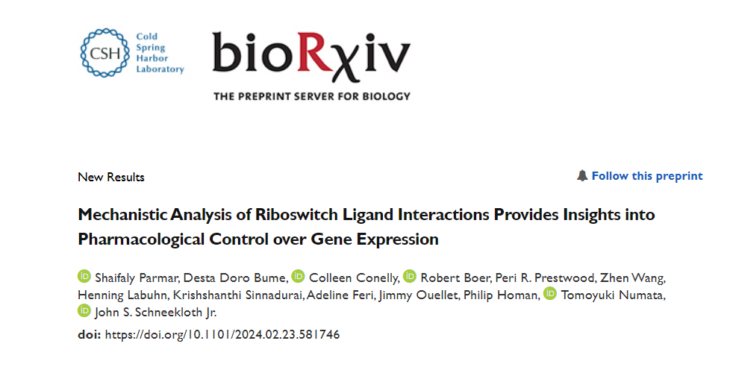We’ve been working with Dr Jay Schneekloth, a leading expert in RNA-targeted drug discovery, to use our MAGNA™ technology to probe the interactions between the PreQ1 bacterial riboswitch and its natural ligand or a synthetic small molecule.
In a paper published as a preprint on bioRxiv and submitted for publication in a high impact journal, we showed how MAGNA provided novel insights into the distinct mechanisms of action of different ligands upon the target RNA at single molecule resolution.
What is the PreQ1 bacterial riboswitch?
Riboswitches are structured sequences of RNA that are commonly found in the 5′ untranslated regions of bacterial mRNAs and help to control metabolic pathways. They work through direct binding of a ligand such as a metabolite to the riboswitch, which induces a conformation change to their secondary structure and alters gene expression.
The PreQ1 riboswitch regulates downstream gene expression for the biosynthesis of queuosine in response to a metabolite called PreQ1 (7-aminomethyl-7-deazaguanine). Upon binding of PreQ1 the RNA changes into a shape known as a pseudoknot, which alters gene expression at either the transcriptional or translational level.
The ability of riboswitches to modulate bacterial gene expression in response to small molecules such as metabolites makes them an attractive group of novel antibacterial drug targets.
Using MAGNA to explore RNA-ligand interactions
Based on magnetic force spectroscopy, MAGNA is the first technology for exploring dynamic molecular interactions in real time from up to thousands of individual molecules. Here, we used it to probe the interactions between the PreQ1 riboswitch RNA from Bacillus subtilis (Bsu) and its natural ligand, PreQ1, or a synthetic ligand named Compound 4.
MAGNA allows us to precisely measure the effects of applying constant or gradually changing (ramped) forces to hundreds of immobilized riboswitch RNAs simultaneously (Figure 1A). This enabled us to capture the exact point at which each RNA molecule changes conformation.
We found that both PreQ1 and Compound 4 stabilized the riboswitch RNA structure, requiring more force to unfold it (Figure 1B). We were also able to explore the concentration dependency of their effects (Figure 1C, E, F).
While both PreQ1 and Compound 4 bound to the riboswitch RNA and stabilized it, analysis of the data streams from single molecules generated by MAGNA revealed that the two ligands had different modes of action (Figure 1D). Unlike the natural ligand, Compound 4 does not induce the pseudoknot structure in the RNA – a distinction that would be missed by only looking at bulk, averaged measurements.
Figure 1: (A) Overview of MAGNA as a single-molecule platform for exploring the interactions of bioactive small molecule ligands with their target RNA structures in real-time (B) Unfolding force distributions of the Bsu PreQ1 riboswitch aptamer in control (DMSO), Compound 4 and PreQ1 ligand conditions (C) Dose-response curve for the change in unfolding of the aptamer in the presence of 4 and PreQ1 (D) Raw traces of the constant-force experiments for control, 4 and PreQ1 of a single molecule with cumulative density histograms shown to the right. (E) The aptamer unfolding rate as a function of the concentration of 4 in constant force experiments. (F) The impact of PreQ1 ligand concentration on the occurrence probability of the stable folded state. n is the number of molecules analyzed. Taken from Parmar et al (bioRxiv, 2024).
In addition, Schneekloth and colleagues explored other structural aspects of the interaction between the riboswitch and various ligands, and their impact on gene expression in live bacterial cells. They were also able to show that Compound 4 could bind in a similar way to PreQ1 riboswitches from other species of bacteria, building up a fuller picture of the properties of this novel molecule.
Deeper insights for RNA-targeted drug development
Overall, the findings presented in the paper demonstrate that even though different ligands may appear to be the same in terms of RNA binding site and impact on gene expression, other factors including selectivity, mode of recognition, and impacts on both conformational kinetics and thermodynamics, can all play a role in the ability of a compound to modulate biological function. These subtle yet important distinctions may not be apparent using analytical methods that rely on surrogate outputs or bulk measurements.
MAGNA’s unique single molecule approach enabled the Schneekloth team to visualize the binding of a novel ligand to its target in real time and gather insights into the distinct mechanisms of action, which would not have been possible using other methods.
With MAGNA we now have a technology that can not only identify compounds that bind to RNA, but also directly reveal how they impact its structure and function at the level of individual molecules. And we can use it to generate detailed information about the kinetics and concentration dependence of ligand binding.
These results demonstrate the capabilities of MAGNA to deliver valuable data about individual dynamic molecular interactions at scale, supporting lead selection in the development of novel RNA-targeted therapeutics.
Read More here: https://depixus.com/using-magna-to-explore-drugs-targeting-rna-riboswitches/


No comments yet